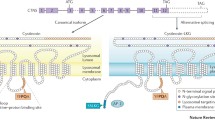Abstract.
Cystinosis is a lysosomal storage disease which is the most-common inherited cause of the Fanconi syndrome. Insights into the pathophysiology of the proximal tubular defect have come from in vitro studies of the cystine-loaded tubule. Proximal tubules loaded with cystine have a generalized proximal tubule transport defect characteristic of the Fanconi syndrome. The decrease in proximal tubular transport with cystine loading is not due to an increase in paracellular permeability with backflux of solute transport from the blood to the tubular lumen, but due to a decrease in active transport. The Na-K-ATPase activity is intact under V max conditions in cystine-loaded tubules; however, the production of ATP is severely compromised. The cystine-loaded tubule has a lower intracellular phosphate concentration than that of control tubules. This low intracellular phosphate concentration in cystine-loaded tubules likely plays a critical role in the decrease in intracellular ATP. Preservation of intracellular phosphate at control levels prevents the decrease in intracellular ATP and the proximal tubule respiratory dysfunction with cystine loading. The clinical significance and future directions for investigation are discussed.
Similar content being viewed by others
Author information
Authors and Affiliations
Additional information
Received November 17, 1997; received in revised form and accepted January 23, 1998
Rights and permissions
About this article
Cite this article
Baum, M. The Fanconi syndrome of cystinosis: insights into the pathophysiology. Pediatr Nephrol 12, 492–497 (1998). https://doi.org/10.1007/s004670050495
Issue Date:
DOI: https://doi.org/10.1007/s004670050495




